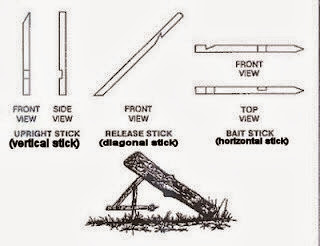MOST STUDENTS, TAKING BUSHCRAFT/SURVIVAL COURSES, WILL HAVE NOTHING BUT PROBLEMS, WHEN TRYING TO CONSTRUCT THE FIGURE- 4 TRIGGER. THE PROBLEMS WERE CREATED WHEN SOMEONE, AT SOMETIME, DECIDED TO GET "ARTISTIC" AND SHOW THEIR GREAT INGENUITY. BEST, KEEP IT SIMPLE.
SUGGESTION: SHORTEN THE EXISTING UPRIGHT SUPPORT STAKE ADD AN ANOTHER;TO BE LOCATED TO THE EXTREME LEFT ACCORDING TO DIAGRAM. THEN, KEEP WHAT IS SHOWN AS A DIAGONAL RELEASE STICK AS VERTICAL AS POSSIBLE.
Deadfalls are usually designed or should I say intended for the catching of smaller carnivorous/omnivorous animals but even so they require the implementation of considerable weight, as such animals are very resilient and their legs will act as shock absorbers. The environmental terrain where they live, in Canada, is usually covered with soft moss or tundra.
The basic principle of the Figure-4 trigger, how it is supposed
to work:
A log, or logs, a Wily Coyote sized rock, or other weight rests on the end of the diagonal stick. This supplies downward pressure to the end of that stick.
- The diagonal stick rests on and pivots on the vertical stick. This keeps the diagonal stick from slipping away to the left.
- The diagonal stick is also held in place by having the end rest in a notch on the horizontal stick. Obviously, the pressure of the diagonal stick is pulling the horizontal stick towards the left.
- The horizontal stick is held in place by notches in both it and the vertical stick. These notches are the actual trigger mechanism. Note: the slight undercut given the notch, in the horizontal stick, intended to hold the diagonal stick in position.
- The bait is placed at the end of the horizontal stick, to the right, directly under the weight.
- When the animal takes the bait at the end of the horizontal stick the trigger is released. The horizontal stick falls to the ground, and the diagonal stick flips upwards and out in a counter-clockwise arc. This allows the weight to come crashing down on the animal, supposedly killing it instantly.
NOTE: For deadfalls, the vertical stick should be resting on a hard surface, such as a flat rock. Otherwise it will dig into the ground and not fall out of the way when the trap is triggered--the dead fall weight will again come to rest on the vertical stick and will not come "crashing" down.
SECOND NOTE: It is a good practice to put something hard on the ground (a rock) under the whole trap; otherwise, the weight may not kill the animal, only pressing it into the soft ground.
But, the best laid plans of mice and men oft times go afoul. The figure-4 triggering device looks fancy--on paper.
It may even work--during practice--when you are constructing the device out of machined dowelling, or twigs, and also using very light weights.
In actual field use, the chances are very much stacked, that it will not function; for the following reasons.
- The downward pressure that the weight supplies directly to the diagonal stick will also produce an upward lifting force at the other end-the end that-in order for this trigger to work-- has to fit in, and STAY in, that notch in the horizontal stick-which it will, of course, not do, especially if the pole is a mere twig and it is fashioned from green wood which will tend to bend and separate easily.
- To complicate the problem; there will also probably be a diagonally, down pushing force exerted on the vertical stick. This force will tend to topple the vertical stick prematurely.
- Actually, as it is shown in any and all photos, or diagrams, I have ever seen of the figure 4 triggering device, there is absolutely--and I do mean absolutely, nothing; other than a single small notch, that, in order to have any
possibly of supporting a weight heavy enough to kill any animal-except perhaps-a mouse, or lemming, has to be cut with exact precision-holding the horizontal stick in place; the diagonal stick is usually not tied to it in any way(the one exception being when cordage is used instead of a diagonal pole).
- Then too, I have never seen an illustration or photograph in which the support sticks themselves were anywhere near strong enough to support a weight heavy enough to kill a beaver, porcupine, or even a large hare or rabbit
(all of which are very unlikely to take any bait-except perhaps a salt lick-anyway).
- In order for this trigger to hold together, the way the trigger sticks are cut, the shape, weight, and placement of the dead-weight; everything about the fabrication has to be very precise. Even so. it is apt to be so delicate that a stiff breeze will trigger it-if indeed, it can be triggered at all-or by anything lighter than an elephant.
- My advice here: use my above suggestion; which is also the trigger I describe in my post on the simple snare; it is far less complicated and will be far more reliable.








